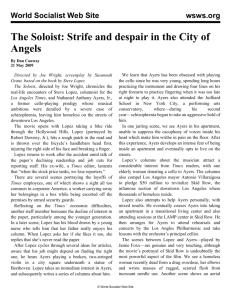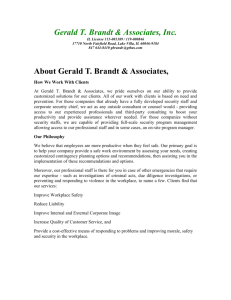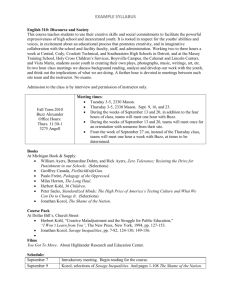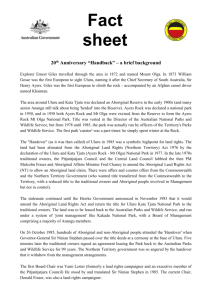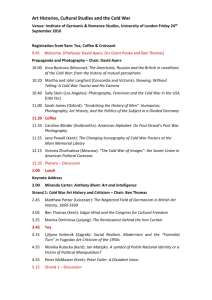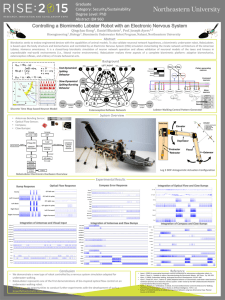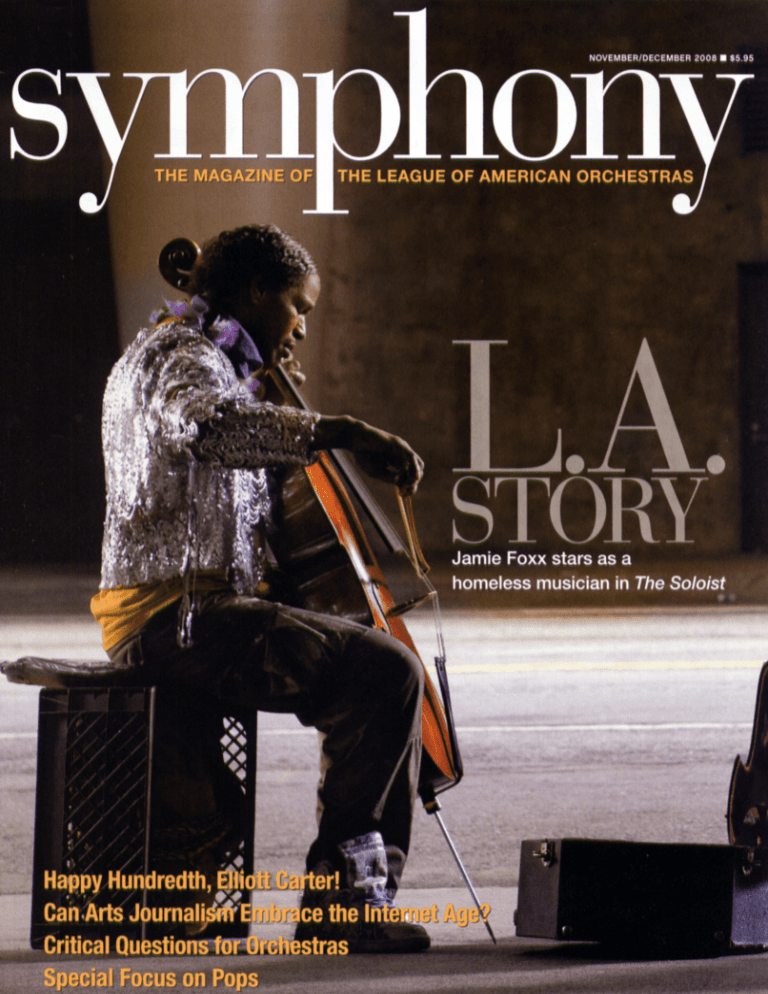
Nathaniel Ayers,
shown playing
violin in Disney Hall,
is now closer to
the profession he
once pursued as a
student at Juilliard.
Los Angeles Times Photo by Damon Winter
L.A. Story
by Josef Woodard
Nathaniel Ayers, a onetime Juilliard
student who spent many years living on
the streets of Los Angeles, has managed
to reconnect with the classical music
world he loves. His story has been
chronicled in a newspaper series, a book,
and now a Hollywood movie starring Jamie
Foxx and Robert Downey Jr.
High in the ranks of stubborn cultural
stereotypes is the notion of classical music,
and particularly the symphonic institution,
as the House on the Hill. Pop culture—in
all its glitz and overpaid noise and the
hurly-burly of urban life—carries on below,
the stereotype goes, while orchestras go
about their elite ways in closed, detached
quarters. Since 2003, the Los Angeles
Philharmonic has been ensconced in its
sparkly architectural showpiece that is
the Frank Gehry-designed Walt Disney
Concert Hall, a civic crown jewel nestled,
yes, high on Bunker Hill in Los Angeles,
in close proximity to decrepit areas just
down the hill.
But the L.A. Phil’s reality is anything
but closed-off or elitist. Apart from the
orchestra’s concerted efforts in community
engagement and in marketing to new
audiences, the remarkable saga of suddenly
famous homeless musician Nathaniel
Anthony Ayers plays into the seeming
paradox of high culture and down-on-luck
human circumstance. These days, Ayers,
who plays double bass, cello, violin, trumpet,
and piano, has a strong and abiding
connection to the orchestra. He regularly
attends concerts at Disney Concert Hall,
enjoys camaraderie with those involved in
the organization, and takes periodic lessons
from its members.
Now the subject of a book—Steve
Lopez’s moving The Soloist—and a March
2009 feature film starring Jamie Foxx and
Robert Downey Jr., Ayers has come a long
way in a relatively short time from his days
as an unknown musician practicing in the
reverberant subterranean quarters of the
Second Street Tunnel, a block from Disney
Hall. Ayers called this unceremonious
tunnel his “Little Walt Disney Concert
Hall.” At this point, Ayers is a curious kind
of celebrity, hiding in plain sight.
Only a few years ago, Ayers was a
homeless man scuffling around downtown
Los Angeles, moving in and around its
infamous Skid Row. Diagnosed as a
schizophrenic and given to occasional
erratic displays of paranoia and rage,
Ayers joined the city’s discouragingly
dense population of mentally disabled and
homeless residents. But his back story was
especially compelling and poignant, as Los
Angeles Times columnist Lopez discovered
upon investigating, befriending, and
championing the musician. Lopez first
heard Ayers performing in the Second
Street Tunnel, and soon discovered that he
had been a promising double bass student
at The Juilliard School in the 1970s, when
the onset of mental demons derailed his
musical course.
A few decades ago, Ayers had been a
model musician with a promising future.
He rose from an impoverished upbringing
in Cleveland. His father had left the family
when Ayers was eleven, but a supportive
high school music teacher, William Moon,
recognized young Ayers’s gift and became
a catalyst for the path to Juilliard. Another
important early contact and inspiration for
Ayers was teacher Harry Barnoff, a member
of The Cleveland Orchestra.
At the time Lopez first encountered
him, Ayers had been living in Los Angeles
for decades—partly because his father once
lived there, partly because of the somewhat
surreally placed statue of Beethoven that
stands a few blocks from Disney Hall
in Pershing Park. A community fixture
since 1932, the monument to Ayers’s
favorite composer is one that he regards as
something of an omen, an anchor for his
otherwise unmoored existence.
In 2005, Lopez wrote an immensely
popular series of Times columns on his
connection with Ayers, as well as Lopez’s
39
40
Borda explains that “it was Steve who
connected him with Adam and then all of
the people at the Philharmonic who have
been involved with him. Why are they
drawn in? Because it is a compelling tale.
It’s an everyman’s tale of terror. Here was a
person who was talented, gifted against all
odds, an African-American at Juilliard at a
time when that was not common. There’s
Mathew Imaging
recalls. “It was remarkable. We snapped
into discussions about conductors, and then
we went from there. We just clicked.”
After being given a tour of the hall
in 2005, Ayers was invited into Crane’s
office to try out his own cello. (Crane had
studied that instument in his hometown
of St. Louis before moving into public
relations.) “We both spoke the same
Above: At the Hollywood Bowl in July,
Nathaniel Ayers (second from left) was
welcomed by some of the L.A. Phil’s “Team
Nathaniel” (left to right): cellist Peter Snyder,
P.R. director Adam Crane, violinist Robert
Gupta, conductor Lionel Bringuier. Left: Ayers
at the Hollywood Bowl with Steve Lopez,
author of The Soloist
Gilles Mingasson
attempts to get him help and into the
downtown rehabilitation and residential
facility known as Lamp Village.
In the process of befriending Ayers
and chronicling his existence, Lopez got
a firsthand view of a blighted area of the
city, rife with disenfranchised denizens,
mentally disabled persons, prostitution,
homicides, and rampant drug use. In an
effort to get inside Ayers’s reality, Lopez
spent a night sleeping on the street with
him, but was kept away by the image and
the actuality of scurrying rats. Ayers had
learned to inure himself against the rough
aspects of street life, and his irascible
temper worked as a shield.
“In more than 30 years as a journalist,”
says Lopez, “I can’t even recall all the
great adventures I’ve had, but yes, this
ranks among the most challenging and
rewarding. It’s also the story in which I
became the most invested personally. I’ve
learned patience and compassion in new
ways, and I have come to better appreciate
the power of art and music as a healing and
sustaining force.”
Another aspect of Lopez’s role in the
drama was introducing Ayers to the L.A.
Phil, starting with Adam Crane, then
the orchestra’s public relations director.
Through Crane, Ayers heard one of the
orchestra’s rehearsals, met Yo-Yo Ma (who
extended considerable warmth to his
onetime Juilliard schoolmate), and struck
up relationships as friend and student of
orchestra members including cellist Peter
Snyder—who first gave him lessons—cellist
Ben Hong, and his most recent contact,
violinist Robert Gupta.
From the beginning, Ayers was
welcomed into the L.A. Phil family, as
Crane recalls. Like many Angelenos, Crane
was a regular reader of Steve Lopez’s Times
column, which he says was his introduction
to Ayers. The idea of having Ayers attend a
rehearsal was cleared with Deborah Borda,
president and CEO of the Los Angeles
Philharmonic Association, and Music
Director Esa-Pekka Salonen. Lopez made
the arrangements to get Ayers inside the
hall, but much coercion and finessing was
required, with Ayers refusing to part with
the shopping cart that held his instruments
and other worldly possessions.
Ayers was almost instantly transformed
upon entering the hall. “The Nathaniel I
met was gracious and engaging,” Crane
language,” Crane says. “But for Nathaniel,
it was an opportunity to go back to his
college mind, when he was at Juilliard, and
he was able to talk about conductors. He
knew a lot. I was shocked.” Their rapport,
says Crane, “was obviously very genuine
on both sides.”
Crane reports that he still gets phone
calls from Ayers every day, sometimes in
rambling messages in which Ayers pays his
respects to every member of the orchestra’s
bass section. This summer, Crane was
worried about Ayers’s response to news that
he would be moving to St. Louis to take a
new job as director of communications with
the Saint Louis Symphony Orchestra. For a
time, Ayers decided he, too, would move to
St. Louis. So far, L.A. remains his home.
also the power of Nathaniel. When you’re
with him, there’s a special presence. He
pulls you in. The way he speaks is brilliant
and totally creative and difficult to follow,
but engaging and absorbing.”
Borda says she’s watched Ayers since
his first day inside Disney Hall, “coming
to rehearsals and to concerts, and really
enjoying music, studying with various
members of our orchestra, and sort of being
adopted by the Los Angeles Philharmonic.
When he gives concerts, he’ll go out on the
street and play in front of the Walt Disney
Concert Hall.”
Social Responsibility
Ayers’s personal attachment to the
orchestra, says Borda, “perhaps wouldn’t
have happened at an institution that didn’t
think a little bit differently. At the Los
Angeles Philharmonic, we constantly are
thinking not only about how we are living
now but how we imagine ourselves in the
symphony
november–december 2008
Francois Duhamel Copyright 2008 by DREAMWORKS LLC and UNIVERSAL STUDIOS. All rights reserved.
future. What we feel is a tremendous sense
of musical responsibility, but also social
responsibility. The other thing is that this
organization has a heart and feel to it.
You can feel it in our relations with the
musicians and the musicians’ relations with
their audience and as they work as teachers
and with their conductor. It probably
reflects what is a very open and wonderful
group of people. One of the things that I
noticed when I moved from the East Coast
to the West Coast—one of the things I
loved—is that if we had an idea, we just
tried it. This is sort of in that same spirit.”
Assessing Ayers’s playing, Crane
comments that “in his mind, it should be
at a level that he can’t get to yet, and may
never get to again. It’s frustrating for him.
In a scene from the movie, Jamie
Foxx (Ayers) and Robert Downey Jr.
(Lopez) look for a place to stash Ayers’s
shopping cart, which he could not bring
into Disney Hall.
www.americanorchestras.org
He does work at it, though. He practices
and is clearly determined. He’s studying
violin with Robert Gupta. He gets his
assignment and goes out and practices, and
will have it down. He hears the notes. His
pitch is good. He was a Juilliard-trained
bassist, so he clearly is talented. I noticed
that instantly when he sat down and
played the cello. He was very rusty. He has
improved. It’s like night and day compared
to where he was when I first met him.”
Gupta, a twenty-year-old violinist new
to the L.A. Phil, was asked by Ayers—
through Lopez—to give him violin
lessons. For the first lesson, in a Disney
Hall practice room, Gupta had planned to
run through the Bach Double Concerto in
D Minor. “Nathaniel came in, and he was
decked out in this flag he had strapped to
himself. There was a violin hanging from
one shoulder, and a trumpet hanging from
the other shoulder. I don’t think he had his
cello with him that day. But he had a chair
with him and a towel. On the chair was
written ‘no smoking, Steve Lopez, Adam
Crane, the Los Angeles Philharmonic.’
41
That’s how I first encountered Nathaniel,
in my capacity as his violin teacher. That
became, for me, one of the most special,
moving, and inspiring experiences of my
life, because I saw from the very outset,
the very beginning, that this is a man who
had a tremendous musical knowledge. The
playing was far removed from the point
when we started the lesson. He wanted to
talk about music. And so we got to talking
about the Mozart symphonies and the
Brahms German Requiem, and then works
of Beethoven. Beethoven is Nathaniel’s
favorite composer and also my favorite
composer.”
Like other musicians who have
established relationships with Ayers,
Gupta found in him an astonishing clarity
about musical matters, in contrast to his
fragility in other settings. “His memory is
so sharp, and when he talks about music,
it reminded me of my professors at Yale.
He is the most erudite and sophisticated
and clear conveyor of the subject. It’s a
miracle to behold. It’s very emotional for
me sometimes, because I can see what he
could have been, as a musician, as a bassist,
but also I think he could have been more
than that. He could have been a maestro.”
Hong, who was an adviser on the film
and part of the L.A. Phil’s supportive
“team Nathaniel”—as Crane dubs it—also
feels that Ayers’s link to Disney Hall and
the orchestra has been a critical element
in his recent well-being. “In some ways,”
says Hong, “I believe it has been his
salvation, his drug that keeps him focused
on something. I know that he really loves
music and in some ways he needs the
music to carry on every day. I know he
used to play on the street for seven or eight
hours. This is just who he is.”
Getting Ayers off the street and
into subsidized housing is a big part
of the Lopez-Ayers friendship, as was
reestablishing contact with the music
world he loves so much. “When he was on
the street,” Gupta says, “he was doing it
all by himself. For him to be reconnected
with professional musicians at Disney
Hall, he thought it was a great and rare
opportunity. Because of that, I think he
was really grateful and happy to have
this kind of opportunity and to talk to
somebody else about music. One thing for
sure is that the street can be a potentially
very dangerous place. One needs to be
42
symphony
november–december 2008
very vigilant and tough. In some ways, you
need to build up a wall around yourself.
You can’t be very trusting of everybody
who approaches you, when you sleep on
the street. For him to come to Disney Hall
and feel safe has been a very important
social outlet for him.”
Dramas On-screen and Off
Mathew Imaging
To be the highly public subject of columns
in the Los Angeles Times and a book is
one thing. Having one’s story told in
a Hollywood feature film is another.
Los Angeles
Philharmonic cellist
Ben Hong: “Ayers used
to play on the street for
seven or eight hours.
This is just who he is.”
Unlike some Hollywood films with
orchestras—one recent example being Get
Smart, with a climactic scene in Disney
Hall shot with a glaringly unrealistic
orchestral scenario—this film, directed
by Joe Wright (Atonement, Pride and
Prejudice), has avidly sought authenticity.
For two days in Disney Hall, the actual
Los Angeles Philharmonic, with Salonen
in charge, was filmed for a key scene in
which Lopez and Ayers had their first
cathartic encounter at a rehearsal. Foxx—
who played Ray Charles in the biopic
Ray—joined Downey Jr., while the actual
characters sat in another corner of the
house. Semi-fiction imitated reality, with
reality peering in from the wings.
Those around Ayers worry about
possible fallout from the film’s release,
especially if The Soloist attains even modest
popularity by Hollywood standards. “I
www.americanorchestras.org
don’t know that he fully grasps what’s
going on,” Crane says. “He’ll often say
the movie’s not about him. How can it
really be about him? And then, in a way,
he appreciates it. He’s getting attention
for something he never succeeded at, and
is now being recognized for it—in a very
strange way, but this is what’s happened.
It’s fascinating. I could have driven
through the Second Street Tunnel this
afternoon and he could have been there.
He still lives in his own world. This is not
going to change him. Fame and fortune
and all of that don’t mean anything to
him. He still lives as if he were on the
streets, which he kind of is, still, except
he’s in housing.”
As Lopez says, “We all worry about
the effect of the movie on Nathaniel. It’s
our job, mine in particular, to shield him
from too much intrusion. On the other
hand, though he’s not interested in TV and
movies, he appreciates the book and movie
as a resurrection of a career that went off a
cliff. In some ways, he’s being acknowledged
for his talent, promise, and courage. I think
he appreciates that, even though in his
world popular culture means little.
“There is indeed a risk in having
agreed to a movie, as there was in
writing a book and columns about him.
The prevailing motivator was to take a
powerful human drama and present it in
a way that changes the way people think
about the guy standing on a corner, and
about the way this society has abandoned
some of its most vulnerable citizens. In
humanizing Nathaniel, I’d like to think
we can humanize thousands like him, help
de-stigmatize mental illness, and draw a
sharp focus on the failures of public policy
and social service.”
For the last few years, Lopez has grown
accustomed to regular inquiries from
people as to Ayers’s well-being and general
condition. Asked once again late this
summer, Lopez reports that “Nathaniel
is still a sick man. The disease doesn’t go
away. He has good days and bad. For the
last couple of months, he’s been particularly
well, mellower and more social than usual.
He still builds his days around music,
constantly switching from one instrument
to another. His latest favorite is the piano
in his studio at Lamp Village, near where
he lives.”
One profoundly inspiring aspect in the
still-unfolding Nathaniel Ayers story is his
enveloping involvement with music that
soothes his soul and, on a good day, fends
off demons. It’s a state of grace, in a way,
and a paradigm of what most true artists in
music aspire towards.
As Gupta observes, “Nathaniel is living
proof that art for art’s own sake can survive
and be healing and redemptive. I think
that’s the whole message of Steve’s book,
that music has this quality of redemption.
I believe it saved Nathaniel’s life. It brought
him to the place he is in now. If he didn’t
have music in his life, he would have been
a very different person—one we would not
want to associate with.
“It’s incredible that this story happened
in our beautifully materialistic city of Los
Angeles, that we have this truly human
story. The Philharmonic is an organization
that supports the arts, that is artistic, and
this is why we play. This is why we exist.
I’m honored to be a part of that.”
Josef Woodard is a music writer based in
Santa Barbara. He is currently at work on a book
about jazz saxophonist Charles Lloyd.
43



